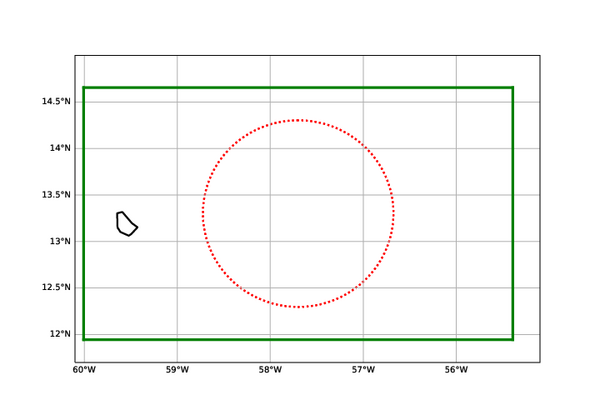Set Up: Periodic Boundary LEMs

Fig. 1 The suggested simulation domain for Large Eddy Modells centered around the EUREC4A circle
Domain Period and resolution
Because of the higher computational costs a smaller domain and a shorter period has been selected for LEMs. The domain is is centered at 13.3º N and 57.7º W and comprises the HALO circle. It is elongated on the zonal (East-West ) direction for a total domain size of 300x500 km2: from the centre, the domain spans 150km North and South, and 250 km East and West. For the vertical domain height of at least 6 km is advised as the heighest clouds can reach heights up to 4 km beyond with a sponge layer of a few km has to be added.
Participants are encouraged to use an horizontal resolutions as close as possible to 100 m, coarser resolutions up to 400 m are also accepted as alternative, or in addition. For the vertical resolution a resolution of 20m near the surface is advised. The grid may be stretched such as to have a resolution of 50m near cloud top height at 3 km.
The simulation period is from 00 UTC on February 1st 2020 to 00 UTC on February 12th 2020. The first day is to be discarded because of the spin-up so that analysis will cover the 10 day period from February 2nd to Februay 11th 2020.
Initial and Lateral Periodic Boundary Conditions
In this case the same COSMO model output can be used for the initialisation and for the surface boundary conditions ( SST and Surface Pressure). The large scale forcings have been derived from ERA5 and can be found here. These large scale forcings include advective tendencies for liquid potential temperature (thl), specific humidity (qt), and for the horizontal velocity components (u,v). Subsidence (wLS) and the geostrophic wind (ug, vg) are also provided, thus not include in the advective tendencies. Note that these tendencies only depend on time and height as they are averaged over the whole Large Eddy Model domain. This implies that all the gridpoints of the Large Eddy Model that are at the same heigh will be feeded with the same large scale tendency.
No double nesting is required in the case of periodic lateral boundary conditions.
REMARK 1: With periodic boundary conditions and forcings that only involve tendencies, runaway effects can easily occur. For this reason participants are advised to use a nudging or relaxation towards the ERA5 mean profiles for temperature (T), total specific humidity (qt), zonal and meridional winds (u, v). So for an arbitrary LES field c(x,y,z,t) this implies
dc(x,y,z,t)/dt = ( c(x,y,z,t) - cERA(z,t) ) / tau
where cERA(z,t) are hourly profiles from a reanalysis describing the evolving mean state of the field c. In order to give the LEM more freedom in the boundary layer we suggest to use longer relaxation times in the boundary layer and shorter ralaxation times higher up in the atmosphere. A relaxation profile can be found here ( and a image here).
REMARK 2: In the case of periodic boundary conditions it is not possible to apply a Psuedo-Global Warming framework as there are no lateral boundary fields that can be perturbed.
Required Output
The required output fields and fluxes are described HERE .
The data for EUREC4A-MIP should be uploaded in the Zarr format. One way to create the zarr data is to save data from the model in netCDF and then convert it to zarr when uploading. Zarr has a similar data model to netCDF, so metadata like units and attributes are preserved when converting. See HowtoEUREC4A for detailed instructions on the format and upload procedure.
